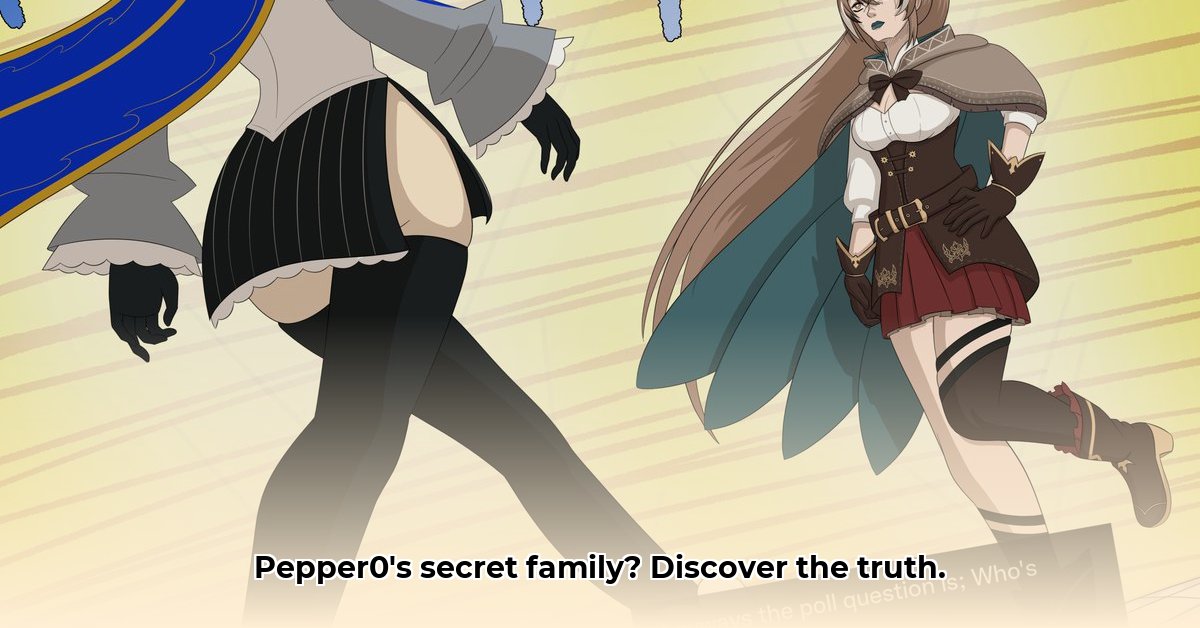Ever heard of Pepper0? This artist’s digital creations, centered around the fictional Akiyama family, have become an online sensation. It’s the compelling story of trauma and healing that has captivated a huge following, not just the art itself. Learn more about Pepper0’s background here. This article explores what makes Pepper0’s art so compelling, why it resonates with so many, the style of the art, the ethical questions surrounding fan creations, and offers tips for responsible engagement. Prepare for a look into a digital art phenomenon and its impact on a passionate online community.
Pepper0 Family Background: Exploring the Digital Art Phenomenon
The internet is home to countless wonders, including the captivating art of Pepper0 and their fictional Akiyama family. These are not merely drawings, but emotion-filled stories painted on digital canvases. The Akiyama family, complete with joys and sorrows, has become a sensation, capturing the hearts of thousands online. This digital art phenomenon raises many questions about digital art trends and online community growth.
Imagine a beautifully illustrated family saga showcasing the Akiyama’s struggles – sibling rivalries, family secrets, and everyday dramas – meticulously crafted in Pepper0’s distinctive style. It draws you in, making you feel part of their world. That’s the power of Pepper0’s art, evoking feelings and artistic expression.
The online response has been explosive. Platforms like PixivFANBOX and Ahri Gallery showcase Pepper0’s work. Passionate discussions are happening on Instagram and in countless online manga communities. People are sharing interpretations, creating fan art, and connecting with the Akiyama family. The relatability factor is most likely driving this incredible connection. We see reflections of our own families, making the art profoundly moving. It makes you wonder, what is the secret behind this surge in popularity of webcomics?
Pepper0’s instantly recognizable artistic style is magical, combining vibrant colors, expressive characters, and a rich atmosphere. It’s not just about appearances; it’s the subtle details, the emotions painted into each line. It’s a unique visual language all their own which is also indicative of current digital illustration techniques.
Beyond aesthetics, Pepper0 masterfully portrays complex themes: family trauma, sibling dynamics, and the painful process of healing. These universal experiences resonate deeply with their audience, speaking to their soul. The depth in this character development is truly unique!
However, this massive popularity has brought about ethical questions. The Akiyama family has inspired a huge wave of fan creations – fan art, fan fiction, and even more explicit content found on sites like Rule34.GG. This is where things get tricky. Where do we draw the line between appreciation and exploitation? These creations spark conversations about the ethical boundaries of fan art.
The lack of clear guidelines from Pepper0 only adds to the uncertainty. There are no official rules about what’s acceptable fan content, creating a bit of a Wild West scenario. This leaves many wondering how to proceed responsibly.
So, what’s the solution? The future of Pepper0’s work and its community relies on tackling these ethical dilemmas head-on. We need more open communication between Pepper0, the fans, and the platforms hosting the art. This is a collective effort towards responsible online community management. As Dr. Anya Sharma, Professor of Digital Ethics at the University of California, Berkeley, states, “The key to navigating these digital landscapes lies in fostering open dialogue and establishing clear, community-driven guidelines.”
Here’s how different stakeholders can contribute to a more ethical future:
- Pepper0 (Artist): Publishing clear guidelines on acceptable fan content assists in setting intellectual property guidelines.
- Online Community: Establishing community-led guidelines for ethical fan creations helps ensure respectful fan engagement.
- Platforms (Pixiv, etc.): Improving content moderation strengthens digital content regulation.
It’s a balancing act – protecting the artist’s vision while fostering creative expression within the community and maintaining the tenets of digital artist rights. The potential for positive growth is huge. The vibrant energy of this online fan community is undeniable; the key is to channel it responsibly, creating a sustainable and ethical space for everyone to enjoy this remarkable art. The journey of the Akiyama family, and Pepper0’s artistic legacy, is still unfolding, and it’s up to all of us to help shape its future. The ongoing discussion will likely refine our understanding and define clearer boundaries in the world of digital art and fandom.
How to Manage Intellectual Property Rights for Digital Fan Art for Ethical Content Creation
Pepper0’s vibrant digital art has captivated online communities. But this success raises crucial questions: How do we balance creative expression with copyright laws? How can fan artists protect themselves? Let’s explore how to manage intellectual property rights for digital fan art as it impacts creative content ownership.
Understanding the Legal Landscape for Digital Art
Creating fan art treads a legal tightrope. Copyright protects original works; fan art, being derivative, falls under these protections. However, “fair use” offers a possible lifeline for non-commercial, transformative works. This means reinterpreting or adding something new, not just copying. Selling your fan art significantly increases the risk of infringement. This understanding of the legal issues in fan art are critical.
Copyright law, enshrined in acts like the Digital Millennium Copyright Act (DMCA) in the United States, grants creators exclusive rights over their original works. This includes the right to reproduce, distribute, and create derivative works. Fan art, by its very nature, often incorporates elements of copyrighted material, making it a derivative work. Therefore, it’s crucial to understand the boundaries of what’s legally permissible.
Navigating the Grey Areas: Fan Art and Fair Use
The line between fair use and copyright infringement is often blurry. A simple redrawing of a character, closely mimicking the original style, is risky. However, a piece that satirizes the original or offers a unique interpretation might have a stronger fair use claim; further, understanding copyright law for digital artists is essential.
The “fair use” doctrine allows limited use of copyrighted material without permission for purposes such as criticism, commentary, news reporting, teaching, scholarship, and research. Courts consider four factors when determining fair use:
- The purpose and character of the use: Is it commercial or non-profit? Is it transformative, adding new expression or meaning?
- The nature of the copyrighted work: Is the original work factual or creative?
- The amount and substantiality of the portion used: How much of the original work was used? Was it a substantial or important part?
- The effect of the use on the potential market for or value of the copyrighted work: Does the fan art substitute for the original work or harm its market?
Practical Steps for Fan Artists for Responsible Content Creation
So, how can you create and share fan art responsibly?
- Understand Copyright Basics: Research copyright law relevant to your country. Know what’s protected. A great starting point is the U.S. Copyright Office website (copyright.gov) or similar resources in your country.
- Prioritize Non-Commercial Use: Avoid selling your work unless you have explicit permission, ensuring ethical digital art practices.
- Be Transformative: Add your unique style or commentary. Make it your own while understanding digital art licensing. For example, instead of simply redrawing a character, place them in a completely new setting or situation.
- Check Platform Policies: Each platform (e.g., DeviantArt, Twitter, Instagram) has its own rules. Follow them. Many platforms have specific guidelines regarding copyright infringement and fan art.
- Consider Licensing: Seek permission from copyright holders. Licensing agreements offer legal protection. Platforms like Creative Commons offer various licensing options that can be used with permission.
- Attribution is Key: Always credit the original artist. Show respect for their work while respecting intellectual property in online art.
- Stay Informed: Copyright law is constantly evolving. Keep up-to-date on changes to copyright regulations. Subscribe to legal blogs and newsletters focused on copyright law and digital art.
For Copyright Holders: A Balanced Approach
Copyright holders also have a role in this delicate dance. While protecting your intellectual property is vital, consider a balanced strategy regarding copyright enforcement.
- Proactive Monitoring: Identify and address infringement, but be mindful of transformative works. Use tools like Google Alerts or specialized copyright monitoring services to track unauthorized use of your work.
- Clear Guidelines: Create a policy on fan art, clearly stating what’s acceptable for fan art usage. Make it easily accessible on your website or social media profiles.
- Licensing Programs: Explore options for fans to officially use your IP through licensing. Services like Patreon can be used to offer tiered access and licensing options.
- Community Engagement: Build positive relationships with fans, fostering a creative and supportive environment. Host contests, feature fan art, and engage in discussions about your work.
The Role of Generative AI in Fan Art
The rise of generative AI tools like Midjourney and DALL-E 2 adds another layer of complexity to the fan art landscape. While these tools can be used to create derivative works quickly, they also raise questions about originality and copyright.
- AI and Originality: Courts are still grappling with the extent to which AI-generated art can be considered original and copyrightable.
- Training Data: Many AI models are trained on copyrighted data, raising concerns about potential infringement.
- **Ethical
- Plastic Bento Boxes Make Meal Prep and Cleanup Effortless - December 8, 2025
- Shop Bento Lunch Boxes on Sale Nearby Now - December 7, 2025
- Shop Bento Box for Sale To Find Your Ideal Lunch Container - December 6, 2025










